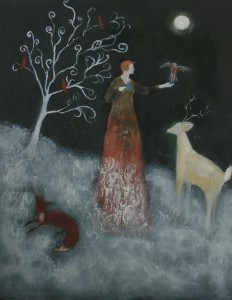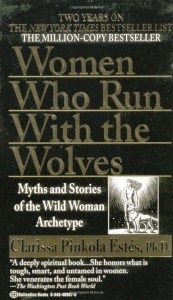Forging a Better Version of Yourself Through Fairy Tales: Lessons for Women
Clarissa Pinkola Estes, in her seminal 1992 book of fairy tales, Women Who Run with the Wolves, says of stories: “In a very real way, we are imprinted with knowing just by listening to the tale.” (p.387)
Participation mystique: Just like living it
Termed “participation mystique” by Jungian psychologists, this notion has more recently been scientifically proven by brain researchers. Your brain really can’t tell the difference between experiences you live through and those you read about someone else living through, even if fictional. Here’s an article in The Atlantic about it. And another in Science.Mic.
For a person like me who makes stuff up for a living, and loves fiction more than life, this is incredibly validating.
Thus we can read stories and fairy tales to expand our experience. The lessons we learn through fiction are real and applicable to the lives we are leading. This is the very purpose of myth. To pass along the wisdom of the ages. To learn from our “elders.”
In this book, Women Who Run with the Wolves, there is a particular story – a dark fairy tale – that Estes believes “deals with most of the key journeys of a woman’s psyche.” It’s one that seems to have particular relevance to women, such as myself, who wake up one day in mid-life and wonder: What happened? How did I get here? Has this happened to you, too? Do you wonder about the choices you made, the lies you told yourself, the sacrifices and compromises that marriage and motherhood and life seem to have demanded of you? Do you look in the mirror and ask: Who am I?
Do you look in the mirror and ask: Who am I?
The story’s called, “The Handless Maiden.” By reading, and slowly absorbing, this tale, we can experience, vicariously–through “sympathetic magic”– the transformations the character experiences over her entire lifetime. That’s a lot of wisdom to help you with your own life stage challenges.
Did You Sign Away Your Self? Time to Toughen Up, Ladies
There is no way to compress all of Estes wisdom into a brief blog post, but I’ll try to highlight the key points. Likely I’m doing her careful arguments a great disservice, but this is meant as an introduction only. Hopefully if this intrigues you you will seek out and read the book, if you haven’t already. Estes suggests taking quite a long time to read the story. Maybe even months. This time is necessary because the lessons of the tale are very, very deep in a woman’s psyche, and you can’t just shake a stick at these parts of yourself and expect understanding, or change.
These deep lessons take place in a female psychic underworld, where we learn knowledge and language from the “Great Wild Mother” who wants to toughen us up to prepare us for life in the topside world of everyday. But we have to go down there to receive these lessons. Way, way down there.
Preparation for real life
In the tale, a series of tests and lessons must be mastered, each requiring a cycle of loss, sacrifice and enlightenment representing “women’s lifelong initiation into the renewal of the wild.”
Synopsis: The Handless Maiden
The tale, in brief synopsis: A man unwittingly sells his daughter to the devil in exchange for riches. She is too pure for the devil to claim, even after her hands are severed. She leaves home to become a beggar. A spirit guides her to a magical orchard, owned by a compassionate king, who falls in love and marries her. He builds her silver hands. She has a baby. The king goes away to war, and the devil interferes again, twisting messages, until the king’s mother is forced to send the queen away for safety rather than kill her. She is taken in by woods people and lives happily for seven years, and slowly her hands grow back. The king returns and seeks her out in the woods, and they live happily ever after.
The Stages:
- The bargain without knowing = The end of innocence. (What poor bargain did you make?) Everywoman gives up her deep self knowledge and power for a more frail self. We trade our wild selves for the promise of riches, but the reward is hollow. We choose superficial riches and gives up dominion over some part of our passionate, creative and instinctive life. We become a sleep-walker, yet this is a necessary step on our journey. A catalyst. The father who guides us is ignorant of the connection between the inner and the outer worlds. Things are not what they appear to be.
- The (symbolic) dismemberment, or separation from false life/innocence
- The wandering (foraging for fruit symbolic of feminine strength)
- Finding love in the underworld (she is rescued, but not yet whole)
- Harrowing of the Soul (a time of healing, a shamanistic initiation during which she rediscovers her creative inner strength)
- The realm of the Wild Woman (return to society as a fully empowered, adult woman bringing gifts of knowledge, maturity and fertility.)

art by Jeanie Tomanek http://www.jeanietomanek.com
For a terrifically written, thoughtful and more thorough analysis of this and other fairy tales, as well as art inspired by them, visit my new favorite link, the extremely awesome Terri Windling’s Blog, Myth & Moor.
“The trials these wounded young heroes encounter illustrate the process of transformation: from youth to adulthood, from victim to hero, from a maimed state to wholeness, from passivity to action. Fairy tales are… maps through the woods, trails of stones to mark the path, marks carved into trees to let us know that other women and men have been this way before.”
Windling concludes her analysis by saying: “Likewise, we’re not meant to remain in the circle of enchantment deep in the fairy tale forest — we’re meant to come back out again, bringing our hard-won knowledge and fortune with us…in service to the family (old or new), the realm, the community; to children and the future.”
Inspiration for Writing and Life
A better source of inspiration for writing women’s fiction I can’t imagine. One of my novels, a work-in-progress entitled “Coming About,” is a more intentional exploration of a woman’s journey through various stages of this process of metaphysical maturation and self-discovery. It’s about a woman who values her professional success as an architect over her selfhood as a woman. At the beginning, she has figuratively sold her soul to the devil by having an affair with her boss, and must lose everything she values and go on a spiritual retreat to learn how to integrate her inner and outer worlds.
This journey also serves as a metaphor for a writer’s life. What are we, as storytellers, doing, besides entertaining our readers, if not bringing our life’s journey to bear on stories that are a product of our creative imagination. For what purpose? To share them with our community, and our children. As I said earlier, this is the very purpose of myth – and of story. To pass along the wisdom of the ages.
If you’re a writer, have you applied this framework of the heroine’s journey to your writing? And whether you are or not, does this fairy tale speak to you in terms of your own life journey?

